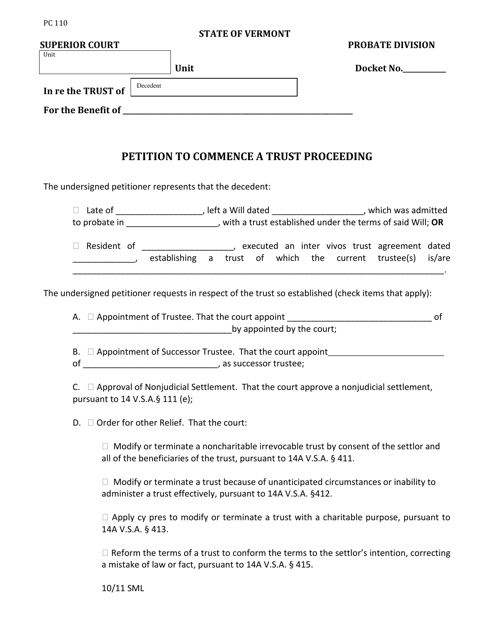Form PC110 Petition to Commence a Trust Proceeding - Vermont
What Is Form PC110?
This is a legal form that was released by the Vermont Superior Court - a government authority operating within Vermont. As of today, no separate filing guidelines for the form are provided by the issuing department.
FAQ
Q: What is a PC110 Petition?
A: A PC110 Petition is a legal document used to commence a trust proceeding in Vermont.
Q: Who can file a PC110 Petition?
A: Any interested party, such as a beneficiary or a trustee, can file a PC110 Petition in Vermont.
Q: What information is required in a PC110 Petition?
A: A PC110 Petition typically requires information about the trust, the parties involved, and the reason for commencing the trust proceeding.
Q: Do I need an attorney to file a PC110 Petition?
A: While not required, it is highly recommended to seek the advice of an attorney when filing a PC110 Petition to ensure compliance with the relevant laws and procedures.
Q: What happens after filing a PC110 Petition?
A: After filing a PC110 Petition, the court will review the petition and may schedule a hearing to address the issues raised in the petition.
Q: Can a PC110 Petition be contested?
A: Yes, interested parties have the right to contest a PC110 Petition by filing a response and presenting their arguments to the court.
Q: What is the purpose of a trust proceeding?
A: The purpose of a trust proceeding is to address issues or disputes related to a trust, such as interpretation of the trust terms or removal of a trustee.
Q: Are there any filing fees for a PC110 Petition?
A: Yes, there are filing fees associated with filing a PC110 Petition. The specific fees may vary depending on the court where the petition is filed.
Q: How long does it take to resolve a trust proceeding?
A: The timeline for resolving a trust proceeding can vary depending on the complexity of the issues involved and the court's schedule. It may take several months or longer to reach a resolution.
Form Details:
- Released on October 1, 2011;
- The latest edition provided by the Vermont Superior Court;
- Easy to use and ready to print;
- Quick to customize;
- Compatible with most PDF-viewing applications;
- Fill out the form in our online filing application.
Download a printable version of Form PC110 by clicking the link below or browse more documents and templates provided by the Vermont Superior Court.






